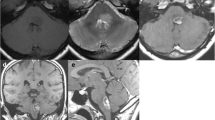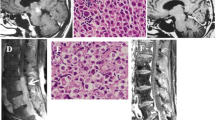Summary
A spontaneous regression of the lesion seen in sequential computertomographic scans does not necessarily indicate a nonneoplastic nature of the pathological process. Two patients with pathologically verified glioma of the brain which showed a temporary regression of the mass effect are reported, and the mechanism of the regression of computertomographic mass signs is discussed.
Similar content being viewed by others
References
Bolwing, T. G., Hertz, M. M., Holm-Jensen, J., Blood-brain barrier permeability during electroshock seizures in the rat. Eur. J. Clin. Invest.7 (1977), 95–100.
Handa, J., Meyer, J. S., Yoshida, K., Regional pharmacologic responses of the vertebral and internal carotid arteries. J. Pharmacol. exp. Ther.152 (1966), 251–264.
Kazner, E., Wende, S., Grumme, T. H., Lanksch, W., Stochdorph, O., Computed tomography in the intracranial tumors. Differential diagnosis and clinical aspects, pp. 22–194. Berlin-Heidelberg-New York: Springer. 1982.
Knopman, D., Margolis, G., Reeves, A. G., Prolonged focal epilepsy and hypoxemia as a cause of focal brain damage: A case study. Ann. Neurol.1 (1977), 195–198.
Kurimoto, T., Mizuno, M., Tani, S., Miki, K., Kawamura, Y., Matsumura, H., Clinical manifestations and computed tomography of the pseudovascular form of metastatic brain tumor. Progr. Comput. Tomogr. (Tokyo)4 (1982), 437–444.
Lee, S. H., Rao, K.C.V. G., Primary tumors in adults. In: Cranial Computed Tomography (Lee, S. H.,et al., eds.), pp. 241–293. New York: McGraw-Hill. 1983.
Lehman, H. J., Der Juxtaneoplastische ischaemische Insult. Nervenarzt51 (1980), 733–736.
Lorenzo, A., Shirahige, I., Liang, M., Barlow, C. F., Temporary alteration of cerebrovascular permeability to a plasma protein during induced seizures. Am. J. Physiol.223 (1972), 268–277.
Matsuda, M., Nakasu, S., Handa, J., Intracranial pressure response to electroencephalographic changes in epileptic seizures and barbiturate coma therapy. Vth International Symposium on Intracranial Pressure, Tokyo, May 30-June 3, 1982.
Weingarten, K. L., Zimmerman, R. D., Leeds, N. E., Spontaneous regression of intracerebral lymphoma. Radiology149 (1983), 721–724.
Weisberg, L., Nice, C., Katz, M., Cerebral Computed Tomography. A Text/Atlas, pp. 80–96. Philadelphia: Saunders. 1984.
Weitz, R., Mats, S., Merlob, P., Reisner, S. H., Brain edema in neonatal seizures: The value of computed tomography in the early diagnosis and follow-up. Acta Paediatr. Scand.71 (1982), 873–876.
Author information
Authors and Affiliations
Rights and permissions
About this article
Cite this article
Nakasu, S., Nakasu, Y., Kidooka, M. et al. Transient spontaneous regression of mass effect with glioma. Acta neurochir 74, 53–56 (1985). https://doi.org/10.1007/BF01413278
Issue Date:
DOI: https://doi.org/10.1007/BF01413278




